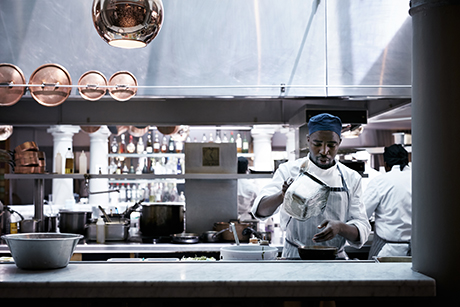
We’re all very familiar with takeout these days, but did you know that your new favourite dish may not actually come from a physical restaurant? It may have come to you by way of what’s sometimes called a “ghost kitchen,” “virtual kitchen” or “dark kitchen.”
While these terms are often used interchangeably, Adam Armeland, CEO and co-founder of “virtual food hall” Kitchen Hub explains the difference: “Ghost kitchens are restaurants that sell exclusively (or predominantly) through digital channels and do not have a direct customer-facing component (with seating, pickup counter, etc.).”

Virtual or dark kitchens on the other hand exist in addition to the traditional brick-and-mortar restaurant structure — and offer customers the option to eat their favourite meals at home. For example, Kitchen Hub is a dark kitchen for some of Toronto’s favourite restaurants, a space where takeout is prepared for PAI Northern Thai Kitchen, The Carbon Bar, Kanga and Cheesecake Factory Bakery. Kitchen Hub also offers customers the advantage of having access to all these different restaurant menus with one order.
Related: Ranking Canadian Retailers Offering Grocery Delivery Right Now, by Price
Differences aside, these all include a centralized commercial kitchen, allowing customers to order menu items online (whether via kitchenhub.ca, SkipTheDishes, Uber Eats, DoorDash or similar food delivery services). “They allow restaurants to take on a smaller footprint, fewer employees and take advantage of the increasing demand for food outside of the restaurant,” says Armeland.
Related: We Tried Popeyes’ Famous Chicken Sandwich That Finally Arrived in Canada – Is It Worth the Hype?

There are more benefits for customers too: “The customer benefits from food being prepared in a facility that is purpose-built for off-premise consumption. Not only will their order get to them faster and fresher, but it will also be prepared in a facility that was designed to have less interaction with the outside world, which minimizes risk [of exposure] to everyone in the process.”
But this model isn’t new — it’s been around since 2013, when the first ghost kitchen opened in New York. Brick-and-mortar restaurants are costly to start up and run — and can be a challenge in the best of times. Enter a global pandemic, hitting the restaurant industry with a $4B drop in revenue between January and April alone. The pandemic catalyzed many restaurants to switch to the ghost or dark kitchen model. “All restaurants effectively became ghost kitchens overnight when the government mandated that they could only be available for takeout and delivery,” says Armeland.

As for what makes a great ghost kitchen? “By and far the most important thing is the restaurant brand and food; the customer wants what they want and from our experience, that is a great brand serving good food,” says Armeland. Kitchen Hub offers the digital and physical infrastructure, allowing the restaurants themselves to focus on what they do best: cooking for their customers. “[At Kitchen Hub] the restaurants operate out of their own dedicated kitchen, with their own chefs, so consumers can expect the same food quality that they have come to love and expect from their favourite brand (or in our case, multiple brands at the same time),” adds Armeland. In terms of what food trends Armeland has noticed throughout the pandemic, he says it’s about the sweet tooth.
Related: Can’t Dine Out? These 20 Toronto Restaurants Are Offering Date Night Meal Delivery
Pandemic or not, Armeland adds: “I think that ghost kitchens are here to stay and are becoming a necessary part of a restaurant’s future planning to serve their customers through the fastest growing channel in the food industry.”
Restaurant photo courtesy of Getty Images; food photos courtesy of Kitchen Hub
